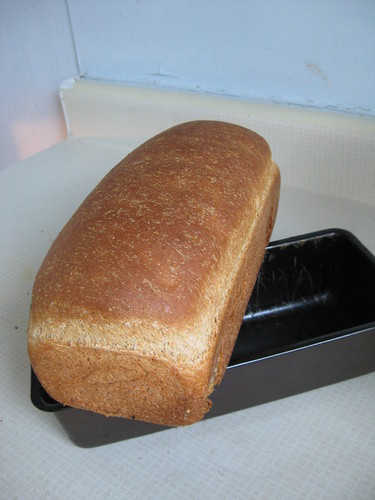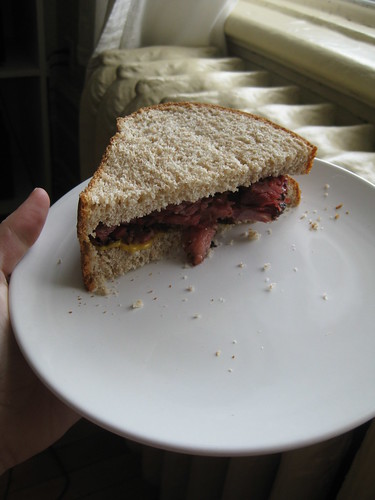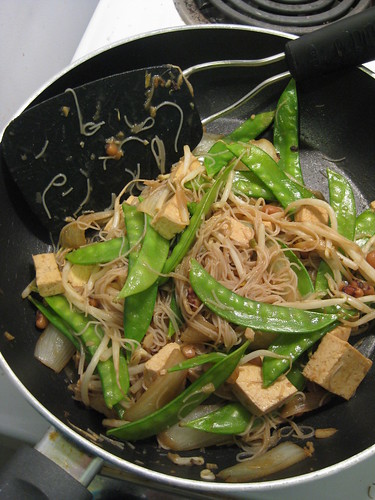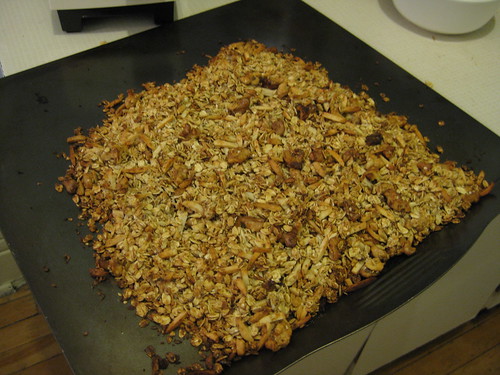So when my dad was a kid he had this neighbour and at some point during his adolescence or early adulthood, she gave him her (very old) copy of
Mrs. Beeton's. When he came to Canada he brought it with him, and it's followed him through the years. As a kid, I was always fascinated by this book. It was so old, the binding crumbling, the pages yellow. I didn't really know what it was or what mysteries it contained, but I held it in great esteem, as it was always brought out to settle disputes over the correct recipe for
Yorkshire puddings, or exactly how to roast a pheasant. (These were common disputes in our house throughout my childhood.) It was the bible of traditional English cooking and Mrs. Beeton's was always the final word. I believe it was even kept on the shelf next to that second most prized book, the Scrabble dictionary. I don't think I've ever actually turned the pages of my dad's copy, although I did use to surreptitiously stroke its spine when no-one was looking. This summer I came into possession of my own, used, copy and while it's not hard-bound and doesn't have quite the same history as my dad's (which I have dibs on, if you're reading this Edward), it does contain the same timeless wisdom about exactly which silks match which complexions, and how to go about getting character references on your servants. And the recipes of course.
Predictably, as it weighs about 6 kilos and I was already over my baggage allowance, I had to leave it in Guelph when I came here (I'm definitely leaving enough room to pick it up at Christmastime though!). But fear not! For it is available in its entirety (maybe minus the plates and engravings)
online.
Now what does all this family folklore have to do with today's post? Well I'll tell you. Quite a few weeks ago now, I bought a huge bag of potatoes for only 86p (CAD1.70 ish). I was down to the last three potatoes and they were getting kind of spongey and I was getting low on money (story of my life). So I thought to myself, what do people with no money do with three potatoes to make them stretch? And I answered myself, make potato soup! And I thought, but in order to make potato soup edible, you need to have fancy things like leeks and cream, which I don't have and can't afford. :( . So then I thought, what else do people with no money eat a lot? (I should probably tell you that my idea of what people with no money eat is largely informed by Oliver! and the little I've gleaned about rural 18th century peasants. And the Depression. Which should explain my lack of imagination, because they all seem to be eating gruel and potato water most of the time.) And I answered myself again, cabbage! So there it was: three manky potatoes and a cabbage. Luckily, I had some stock cubes and some garlic, and I went out and bought an onion specially. So, together with my trusty box of spices (which is falling apart and is now more tape than cereal box), I set to making cabbage soup.
Looking back, I guess that last paragraph didn't really make the link between Mrs. Beeton and cabbage soup explicit. Well, my first step was to look at some of Mrs. Beeton's recipes to see what people with no money ate 150 years ago, because Mrs. B is all about frugality. So I looked at the table of contents on that online version and clicked on the first "Recipes" link I saw, which happened to be
soup recipes. I read all of them and mixed some of them together in my head and was repulsed by a couple of them and ended up with this Mrs. Beeton-inspired recipe, which I will relate to you below.
Cabbage Soup
Ingredients:
Some butter or oil
1-4 potatoes (I used one medium sized and 2 small. Also mine were the kind with white skin and I have never seen the kind with dirty brown skin here... which kind of weirds me out because I thought British people were all about potatoes), peeled (optionally) and cubed
1/2-1 onion, chopped
3-4 (+) cloves of garlic, minced
1 tsp (+) fennel or caraway seeds (caraway would probably be better, but I only had fennel)
1 litre (4 cups? a quart? both?) of stock (chicken, vegetable, whatever. I did 2 cubes' worth of chicken, plus some extra water)
1/2 a small cabbage (I used the curly green kind, which I think would be best, but you could also use the smooth green kind. I don't know how well the purple kind would work as they tend to be tougher), prepared as below
A splash of lemon juice
Salt and pepper
For the cabbage. Take the whole thing and peel off the outer most layer (or 2 layers, or enough layers so that what you've got wasn't in contact with the outside world) of leaves, and lay these aside. Using your biggest, scariest knife (and maybe with a friend to spot you the first couple of times), chop the cabbage in half, then put the flat side of one half down on the cutting board and cut that in half, so you've got one half a cabbage and two quarters. Put the half cabbage away to use for something else. Now take a smaller knife and cut out the tough core. What you've got should look something like this:
(Doesn't it look so pretty and curly?)
Using the bigger knife again, chop vertical slices (so your knife is about parallel to where the core used to be) so that where you're cutting on the outermost leaves is about 2 cm across. Now chop again, perpendicular to your last cuts, so that you've got rectangles of cabbage. The exact size and shape isn't really important, but they need to be able to fit in your mouth and cook relatively quickly. When you've done that for both quarters, take the leaves you laid aside at the beginning. Wash them and stack them so that all the stems line up. Cut the stems out and cut the leaves into pieces about the same size as the others. (This is really difficult to describe, but pretty easy to do.)
- Toast the fennel/caraway seeds in a dry pan until they start to smell really nice. The instant they start going brown, or even a little before (at the height of their smell), pour them into a little bowl or something and save them for later.
- Heat the butter or oil (or both) in the bottom of an appropriately-sized (easier said than done!) pot, enough to cover the bottom.
- Fry the onions on med-low heat, until they are all soft and delicious and maybe starting to get a little bit brown around the edges.
- Add the garlic and the seeds and stir them up a bit. You might need to add a little more oil or butter if things are starting to stick.
- When the garlic is soft, add the stock cubes if using (but not the water). If you're using real stock (fancy!) then just you wait. Mash up the stock cubes into a paste and mix it all together with the onions, garlic and seed.
- Add the water, or the real stock, and the potatoes.
- Bring to the boil and simmer for a while until the potatoes are cooked (the time for this will depend on how big your potato cubes are).
- Add all the cabbage at once, stir it up and simmer for 1-2 minutes. Put a lid on the pot and remove from heat, so that the cabbage can steam without going all slimy like it does when you boil it.
- After a couple of minutes, check back and give it another stir. I like the cabbage al dente, but if you want it softer, you can heat it up again until it's your desired tenderness.
- Season with salt and pepper, and a splash of lemon juice. Serve with croutons, cheesy croutons, or the gratings from that cheese that's been in your fridge for a while that needs to be eaten up but is only really edible at this point if melted.

Mmmmmmmmmmm.








